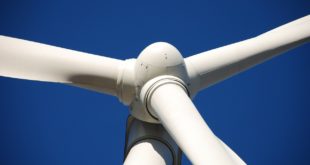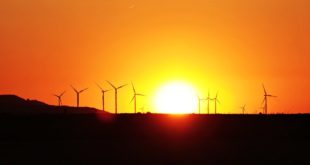Xcel, MidAmerican among leaders as more utilities sign up for consumer savings

U.S. electric utilities are locking in fixed-price contracts for wind power, now more cost-competitive than ever, illustrating the success of a key federal tax policy in holding down rates for consumers.
A total of 66 U.S. utilities bought or owned wind power by the start of this year – nearly half for large amounts over 100 megawatts (MW) – up from 42 a year before. Utilities have continued to sign up for more since Congress and President Obama extended the Production Tax Credit for wind energy in the “fiscal cliff” bill signed at the beginning of January.
“AWEA applauds these utilities for maximizing the PTC opportunity to continue bringing low-cost, fixed price wind power to their customers,” said Rob Gramlich, Interim CEO of the American Wind Energy Association (AWEA).
“From Xcel Energy in Minnesota to OG&E in Arkansas, electric consumers are racking up the savings as a result. The wind energy industry looks forward to our continued partnerships with utilities across the country to lock in the economic development, rate stabilizing and environmental benefits of more wind power.”
Among the utilities making major wind power purchases and reporting consumer savings are:
-Xcel Energy, the number one wind energy provider in the nation, is considering adding more wind generation in Minnesota and Colorado because of the PTC extension.Earlier this month, Judy Poferl, president and CEO, of Xcel Energy’s Northern States Power Company-Minnesota said, “Although Xcel Energy is well ahead of meeting our state’s renewable energy requirements, we are open to adding cost-effective wind projects that could provide long-term value to our customers. The extension of the federal renewable electricity Production Tax Credit may make cost-effective projects available to serve our customers.”
In Colorado, Xcel Energy has repeatedly set national records for generating more than half its electricity from wind power and is now seeking regulatory approval to accelerate its resource acquisition process to allow for the addition of value priced wind energy. “We have a great opportunity to see if additional wind resources in Colorado would be of economic benefit to our customers with the extension of the federal tax credit, but we must act quickly,” said Ben Fowke, chairman, president, and CEO of Xcel Energy. “Our request is not being driven by state renewable energy standards, but by the opportunity to reduce costs.”
-MidAmerican Energy, the No. 1 utility in the U.S. in terms of ownership of wind capacity, announced Dec. 31, 2012 that it had completed three more wind projects totaling 407 MW in Iowa. MidAmerican is a subsidiary of Berkshire Hathaway, the holding company controlled by investor Warren Buffett. “Wind now comprises 30 percent of MidAmerican Energy’s generation portfolio,” announced Bill Fehrman, president and CEO.
-Tri-State Generation and Transmission Association, citing the recently extended PTC and ongoing Renewable Portfolio Standard requirements in moving forward withan RFPto be executed by June 30 for approximately 100 MW of renewable energy to take advantage of competitive market prices.
-Oklahoma Gas & Electric, which in a filing in Arkansas, reported cost savings to its customers from the “clean, renewable energy” of its Crossroads wind farm:
“From September 2011 through June 2012, fuel costs to Arkansas customers were approximately $1.2 million lower because of the incorporation of Crossroads into OG&E’s generation fleet. OG&E estimates that fuel savings to Arkansas customers from September 2011 through December of 2012 will be in the range of $2.2 million. Total Company production cost savings for the first five years of operation are estimated to be $268 million. Over the expected twenty-five-year life of the asset production cost, the savings are estimated to be $2.3 billion.”
-Minnesota Power, part of ALLETE Inc., which completed phases two and three of its 210-MW Bison Wind Energy Center in North Dakota. With the purchase of a direct-current transmission line to Duluth, the company can phase out a long-term contract for coal generation and replace it with wind energy, increasing renewables to 20 percent of its generation mix en route to meeting Minnesota’s goal of 25 percent by 2025. “By meeting an aggressive timetable we are able to capitalize on the wind production tax credits to the benefit of our customers in providing a clean, cost-effective energy resource,” Minnesota Power COO Brad Oachs said in a news release.
– Alliant Energy Corp., a subsidiary of Interstate Power & Light Co., which on Dec. 21, 2012 issued an RFP for approximately 100 MW of wind power in the Midwest.
– Nebraska electric utilities: AlthoughNebraska utilities had not been planning to add more wind power until 2017, Nebraska Public Power District recently signed a purchase agreement for 75 MW; Omaha Public Power District is in the process of signing for an additional 200 MW; and Lincoln Electric is seeking 50 MW, all as a result of the PTC’s extension for projects started in 2013.
– Puget Sound Energy, which announced last week it had set a new record by generating 23.5 percent of its energy from the utility’s three Eastern Washington wind farms:
“This milestone underscores the role wind power can play in meeting our energy needs,” said David Mills, PSE vice president of Energy Supply Operations. “Wind is now a key resource for providing our customers with reliable, affordable electricity. And when combined with our hydro, natural gas and coal power plants, wind gives us flexible, cost-effective options for serving local homes and businesses.”
– DTE Energy: The company’s ECHO Wind project, slated for 2013, will have a combined levelized cost of approximately $52.50 per megawatt-hour (MWh), down substantially from power purchase prices several years earlier, according to the Michigan Public Service Commission. DTE says its investment in that and two other recent wind parks will contribute $150 million in economic benefits to Michigan.
– Consumers Electric Power estimates that Macon County and the state of Michigan received an economic boost of nearly $10 million from the development of the company’s first wind farm, the Lake Winds Energy Park.
The Michigan Public Service Commission said Feb. 15, 2013, in releasing its “Report on the Implementation of the P.A. 295 Renewable Energy Standard and the Cost-Effectiveness of the Energy Standards,” that:
“Compared to building a new, conventional coal facility, renewable energy contracts are significantly lower in price…less than any newly built generation including new natural gas combined cycle plants. Based on contract pricing trends and the January 2013 announcement that federal legislation extended the eligibility of the Production Tax Credit for projects that begin construction by December 31, 2013, Commission Staff anticipates that the cost of renewable energy will continue to decline, while the benefits from energy optimization savings and emission reductions from offset generation will continue to increase.”
As the Michigan PSC noted, utilities are cutting pollution by purchasing more wind energy. Currently installed wind turbines will avoid nearly 100 million metric tons this year of carbon dioxide emissions, for instance, equal to 1.8% of the entire country’s carbon emissions.
Other new wind power purchasers last year included at least 18 industrial buyers, 11 school districts, and eight towns or cities, showing a significant trend toward nontraditional power purchasers from the industrial sector. Manufacturers of everything from plastics to light bulbs, semiconductors, and badges, farms, and medical centers are now directly purchasing wind power.
Spurred by the federal incentive, American wind power grew by 28 percent in 2012 alone, for the first time becoming the number one source of new electric generating capacity, and pouring $25 billion of private investment into the economy. The top states for new installations last year were: 1. Texas, 2. California, 3. Kansas, 4. Oklahoma, 5. Illinois, 6. Iowa, 7. Oregon, 8. Michigan, 9. Pennsylvania, and 10. Colorado.
Illinois saw the installation of over 800 MW, for example, with half that output sold into the Tennessee Valley Authority market. As one of America’s wind power hubs, Illinois is home to wind power innovation. This year saw the installation of the first concrete wind tower there, which the manufacturer says can support taller turbines to access better winds and open up new areas for development.
The global wind energy industry will gather in Chicago this May 5-8, 2013 for the world’s largest annual wind energy event, WINDPOWER 2013. Utility members in AWEA are eligible for a 50 percent discount on a main conference registration this year – to register, click here and use registration code WP13UT today before registration prices increase after March 11th. Thousands of workers and leaders from all sectors will be in Chicago to show their wares, attend conference sessions, and seek further solutions for success.
 Alternative Energy HQ solar power for homes, wind energy, and bio fuel issues
Alternative Energy HQ solar power for homes, wind energy, and bio fuel issues

 Texas Wind Farm Gets World’s Largest Energy Storage System
Texas Wind Farm Gets World’s Largest Energy Storage System








